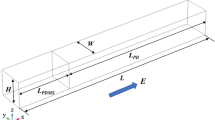Abstract
Simulations have been carried out for water flow in a square microchannel with a miter bend. The simulation considered a pressure-driven flow in a channel-hydraulic diameter of 5 μm for series of Reynolds number (Re) range from 0.056 to 560, in order to investigate water flow at bends. The result shows formation of two vortices after the miter bend, which are more discernible above Re 5.6. The critical inlet velocity for the generation of vortex in this particular geometry occurs at 1 m/s. A simple energy mechanism is postulated to explain the vortex formation as well as core skew direction. The high pressure region at the outer wall before and after the bend is a major factor for vortex formation since the liquid needs to reduce the additional energy effected by the high pressure region. Navier–Stokes equation is utilized with a no slip boundary condition for a total microchannel centerline length of 795 μm which is sufficient to produce a laminar flow pattern at the outlet.







Similar content being viewed by others
References
Bayraktar T, Pidugu SB (2006) Characterization of liquid flows in microfluidics systems. Int J Heat Mass Trans 49:815–824
Cross B, Steinberger A, Cottin-Bizzone C, Rieu JP, Charlaix E (2006) Boundary flow of water on supported phospholipid films. Europhys Lett 73(3):390–395
Hao P-F, Yao Z-H, He F, Zhu K-Q (2006) Experimental investigation of water flow in smooth and rough silicon microchannels. J Micromech Microeng 16:1397–1402
Hossain S, Ansari MA, Kim K-Y (2009) Evaluation of the mixing performance of the three passive micromixers. Chem Eng J 150:492–501
Hsieh S-S, Lin C-Y, Huang C-F, Tsai H-H (2004) Liquid flow in a micro-channel. J Micromech Microeng 14:436–445
Hu G, Li D (2007) Multiscale phenomena in microfluidics and nanofluidics. Chem Eng Sci 62:3443–3454
Husain A, Kim K-Y (2008) Optimization of a microchannel heat sink with temperature dependent fluid properties. Appl Therm Eng 28:1101–1107
Koo J, Kleinstreuer C (2003) Liquid flow in microchannels: experimental observations and computational analyses of microfluidic effects. J Micromech Microeng 13:568–579
Koumoutsakos P, Jaffe RL, Werder T, Walther JH (2003) On the validity of the no slip condition in nanofluidics. Nanotech 1:148–151
Kozicki MN, Maroufkhani P, Mitkova M (2003) Flow regulation in microchannels via electrical alteration of surface properties. Superlattices Microstruct 34:467–473
Lee SYK, Wong M, Zohar Y (2001) Gas flow in microchannels with bends. J Micomech Microeng 11:635–644
Lee G-B, Chang C-C, Huang S-B, Yang R-J (2006) The hydrodynamic focusing effect inside rectangular microchannels. J Micromech Microeng 16:1024–1032
Lima R, Wada S, Tsubota K-I, Yamaguchi T (2006) Confocal micro-PIV measurements of three-dimensional profiles of cell suspension flow in a square microchannel. Meas Sci Technol 17:797–808
Liu Z, Zhang C, Zhao X (2009) Experimental study on influence of microscale effects on liquid flow characteristic in microtubes. Heat Mass Transf 45:297–304
Meinhart CD, Wereley ST, Santiago JG (1999) PIV measurements of a microchannel flow. Exp Fluids 27:414–419
Morini GL (2004) Laminar flow through silicon microchannels. J Fluids Eng 126:485–489
Qu W, Mudawar I, Lee S-Y, Wereley ST (2006) Experimental and computational investigation of flow development and pressure drop in a rectangular micro-channel. J Electron Packag 128:1–9
Tabling P (2005) Introduction to microfluidics. Oxford University Press Inc, New York
Wu HY, Cheng P (2003) Friction factors in smooth trapezoidal silicon microchannels with different aspects ratios. Int J Heat Mass Trans 46:2519–2525
Xiong R, Chung JN (2008) Effects of miter bend on pressure drop and flow structure in micro-fluidic channels. Int J Heat Mass Trans 51:2914–2924
You J, Flores L, Packirisamy M, Stiharu I (2005) Modeling the effect of channel bends on microfluidic flow. IASME Trans 1(1):144–151. ISSN 1790-031X
Acknowledgments
This project is supported by a research grant (03-01-15-SF-0050) from Ministry of Science, Technology & Innovation, (MOSTI), of Malaysia. The author also would like to thank School of Microelectronic Eng. and UniMAP R&D cluster for their support and facilities.
Author information
Authors and Affiliations
Corresponding author
Rights and permissions
About this article
Cite this article
Taniselass, S., Retnasamy, V. & Poopalan, P. Microchannel miter bend effects on pressure equalization and vortex formation. Microsyst Technol 17, 469–475 (2011). https://doi.org/10.1007/s00542-011-1270-6
Received:
Accepted:
Published:
Issue Date:
DOI: https://doi.org/10.1007/s00542-011-1270-6



